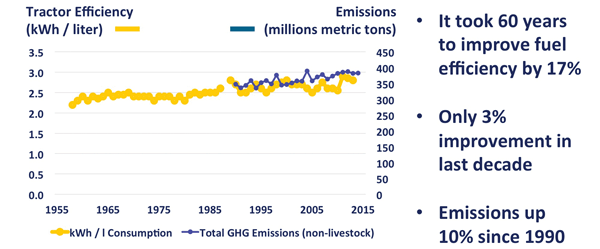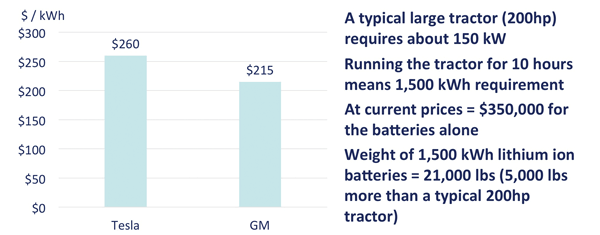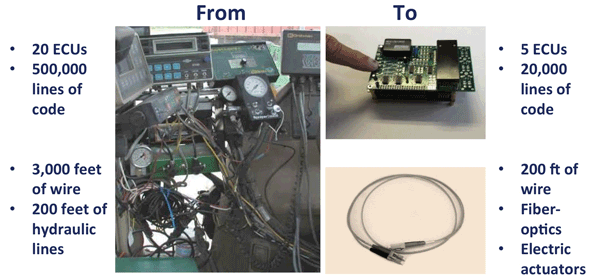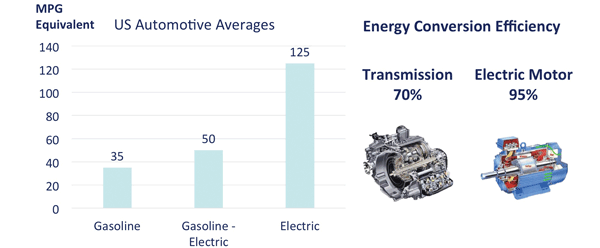Editor’s Note: This article is a portion of what Kraig Schulz presented during his keynote address at the 2017 Precision Farming Dealer Summit in January. In this presentation he discussed the driving forces behind and logistical hurdles to improving autonomy in agriculture.
What does the word autonomy really mean? A lot of people use it but I don’t think most people would agree on a definition. In its broad definition of self-sufficiency, we already see autonomy in the field. We have combines that separate corn from the cob. We have vehicles that steer themselves. According to some people in the industry, we’ve had autonomous vehicles in the field for 20 years. But the question is “what level of autonomy do farmers really need?”
Autonomy is a spectrum. Rudimentary autonomy that must be observed or managed by someone in the vehicle is on one end, and more complex, self-sufficient autonomy is on the other. Maybe down the road we will see tractors that have already gone out and plowed the field and come back while you’re still getting your second cup of coffee, but for now the autonomy we see in farming still requires a certain level of supervision. Autonomy in the truest sense is something that functions completely on its own — something I don’t think we will see broadly adopted among row crop producers any time soon. With that in mind, I suppose Autonomous Tractor Corp. might not be the best name for my company. This is something I realized only after 5 years of working with autonomous agricultural vehicles for row-crop producers. I have a more accurate name in mind, but let me first explain.
Challenge for Farmers
Row-crop farmers face a tough financial situation. I was shocked to find that the average income per bushel of corn (average price minus average cost of production) in the last 35 years was –$0.01. Costs were up 60% and prices were only up 40% during that time period. During the good years we can make more money, but during the bad years we have to rely on what we made in the good years to keep going.
Unfortunately, most experts don’t see things getting better for farmers any time soon. So we are going to have to learn to live in a world where our margins are razor thin — or find ways to cut costs fairly dramatically.
Cutting Costs
Cutting costs is probably the surest way to combat thin margins since we have less control over yield and almost no control over crop prices. Helping farmers make more money, primarily by cutting costs, was the main goal in starting Autonomous Tractor Corp. Farmers’ real on-farm income has been declining for decades, but some innovations in agriculture could help alleviate some of that financial pressure.
Fuel Improvement in the Last 60 Years

Fuel efficiency has only improved 17% in the last 60 years, contributing to rising production costs for farmers in the last 25 years. Source: Nebraska tractor Test Laboratory
What are the big buckets of production costs? Labor makes up only about 5% of production costs of corn in Iowa while equipment, seed and chemicals make up nearly 20% of production costs each and land costs account for nearly 40%. So where should farmers be focused on cost savings? We think attacking the biggest cost categories is probably the right place to start.
ATC is helping farmers cut one of the big cost areas today: equipment. According to Iowa State data, the biggest equipment costs are the initial purchase price, fuel and repair. Between 1975 and 2012, the purchase cost of machinery and its repair have both about doubled. Fuel costs are largely market-driven, but the industry has not made tremendous progress on increasing fuel efficiency, which has only improved 17% over the last 60 years. These rising costs in equipment and maintenance and limited improvement in fuel efficiency have led to almost continuously rising production costs for farmers over the last 25 years.
It raises my ire when I look at the correlation between corn prices and the costs of production. Why? The correlation shows how the suppliers of production inputs (equipment, seed, chemicals, etc.) raise or lower prices to maintain their “share” of farming income. From 1980 to 2015 the correlation between last year’s corn price and this year’s cost of production is 86%. This means that as suppliers see producers’ ability to pay go up, so do input costs. You make a little more money on the farm and your suppliers get ready to take a little more out of your pocket next year, almost dollar for dollar.
Electric Farm Equipment
Electrification might be an answer to some of the problems in rising equipment costs. Electric tractors would get better fuel economy, have an increased longevity and reduced repair costs — all facts that have been proven by the automotive world. Electric drive technology has been adopted by the marine, locomotive and mining industries but not in ag. Isn’t it about time our industry started moving to a more cost-effective solution like electric drivetrains?
Battery Costs

Batteries are a challenge for electric tractors. For a 200 horsepower tractor they would cost about $350,000 and the battery pack would weigh more than the tractor itself. Source: Green Car Reports 2015 L David Roper Tractor Data
Tesla automobiles are a good example to show how electric tractors would be an improvement for farmers. An electric vehicle has only a small fraction of the moving parts of a mechanical or hydraulic vehicle. Since the whole system becomes digitized, the communications systems can be dramatically simplified, eliminating hundreds of wire connections. Using fiber optic cables alone can reduce most of the wires in a tractor to just one cable.
These advances can translate into real dollars for producers. The differences in value after roughly half the life of each type of vehicle can’t be ignored. A Tesla retains better than 70% of its value after 50,000 miles while traditional cars lose 70% of their value. Part of the reason (but not the only reason) for this disparity is the average expected lifespan of an electric motor is 29 years, which is 2 times the average lifespan of a traditional tractor. Farmers would benefit greatly from equipment with longer lifespans and less frequent need for repair.
Fuel efficiency is also a benefit. A gasoline-powered vehicle gets roughly 35 miles per gallon. Moving that to a hybrid gasoline and electric platform would increase efficiency by about 30%, and moving it to a completely electric platform would increase it significantly more. Simply put, transmissions aren’t that efficient and electricity is a much more efficient way to transfer power.
So why hasn’t the ag industry adopted electric drive platforms? The main problem is the vast majority of electric systems use batteries. This works well for the Tesla design since most of the time a driver will only use the Tesla at a fraction of its full horsepower and only a few hours each day.
Simplicity

Electric vehicles have a fraction of the moving parts mechanical and hydraulic vehicles do and electric systems are digitized, eliminating hundreds of wire connections. Source: Rainer Hoffman, AGCO, 2006; ATC Estimates
Teslas today carry about 100-kilowatt hours of batteries, but even just a 200 horsepower electric tractor would need about 1,500 to work for a full day. Batteries alone would cost farmers about $350,000 for this hypothetical electric tractor, not to mention the battery pack would also weigh more than the tractor.
Though electric tractors may seem unattainable in the near future, there is already electrification in today’s farming equipment. An electric generator can now power a John Deere 4930 self-propelled sprayer without batteries that used to be powered by a hydraulic drivetrain. The world is moving to electric vehicles. It might be more gradual, but it will make its way to farms and change the industry.
Electrifying tractors, however, would change many facets of our industry and would require adaptation by many players. For example, dealers would have to re-think their economic model since electric tractors would require less maintenance. How can we keep dealers profitable while their biggest economic driver slowly erodes? A Tesla-type distribution model simply won’t work in ag. But involving the dealers in the installation of electric drive systems would allow them to charge for parts and labor and keep their economics whole.
Problems with Labor
So what about labor costs? Considering labor only makes up about 5% of corn production costs, it would seem that the COST of labor isn’t necessarily the core problem. Instead what I hear time and again is producers’ inability to get the right people on the farm when you need them. Finding experienced seasonal labor can be a major problem for farmers.
There is simply too much work to get done during unpredictable, narrow windows of opportunity — and it is unrealistic for a producer to hire a full-time, year-round staff to meet their highest seasonal needs. Farmers I speak to often say they could just use a “helping hand” — a piece of equipment smart enough to supplement their own labor in the field when they need it.
Trying to solve these labor issues through automation means replicating what an operator would normally do in the field. The list of activities is long, but one activity that has rapidly fallen off over the last 20 years is “steering.” Great advances in GPS-based auto-steer systems have provided tremendous benefits to producers: reduced fatigue, greater precision, less waste, etc. But we still have someone in the cab.
Why? The equipment still requires someone to manage all of the complex operations in the field to ensure the task is being performed in the way that suits his or her needs. Muddy terrain, rocks, leaky hydraulic lines, worn bearings, electrical shorts … if there is no driver, who is going to manage these items in an environment that changes nearly every day? And it isn’t just anyone who can do this. The operator needs to be qualified for the task at hand or profits are lost.
Automation works well for repetitive tasks, but farming is inherently an organic, non-repetitive activity. The conditions and requirements change every day. If a computer has to “learn” all of the requirements under all of the different conditions in order to be self-sufficient, is it efficient for a producer to have to run back out to the field every 30 minutes and teach?
For the time being, it is likely that farmers will need to manage the operations of the equipment. This is the idea behind “semi-autonomy:” a machine smart enough to operate on its own while under the supervision of the farmer who is going to be in the field anyway — a “helping hand.”
Having a machine that operates largely self-sufficiently (semi-autonomously) in the field alongside the farmer could help reduce the need to swell the labor ranks during the short periods of peak season labor demands and allow producers to get more done, more quickly.
Efficiency

Moving to a hybrid gasoline and electric vehicle would increase fuel efficiency by about 30%. A completely electric platform would increase it even more. Source: U.S. Energy Information Administration
But the industry seems fascinated by full autonomy. So I pose the question: even if we could get to full autonomy, how much would you pay to solve a 5% problem? If we don’t change the cost of the underlying equipment and only add cost and complexity to the solution is there really an economic benefit to the producer?
There had better be some pretty spectacular benefits beyond labor cost savings. Greg Peterson, widely known as Machinery Pete, observed that more and more farmers are using older, simpler machines to avoid repairs that involve more complex technologies that are driving the costs of repair up. How does that view square with the drive to add more complex systems to already-expensive tractors?
Semi-autonomous equipment seems to be the answer. Equipment that operates independently enough that the farmer can be within reasonable distance to intervene when a problem occurs is more realistic than fully autonomous equipment. And if the equipment is semi-autonomous, why do we need a tractor to pull it? It may not even need a cab. Why wouldn’t the power and mobility be integrated into the implement itself in a modular fashion that can be moved from implement to implement?
With an electric drive train this is possible — providing even better control of the implement and driving down even further the cost of equipment. Fully autonomous equipment might not be as necessary as we think it is.
My point is that we need to stay focused on the problem: cutting costs out wherever possible and focusing on the largest cost line items. The thoughtful, practical application of new technology to farming operations has the potential to cut many costs by 50% or more. But to get there we need a dramatic re-thinking of our methods and tools.
So back to our company’s name. A name like Semi-Autonomous Self-Propelled Implement Corp. (SASPIC) might make more sense — but it is kind of a mouthful. Maybe we’ll just use ATC for now.








Post a comment
Report Abusive Comment